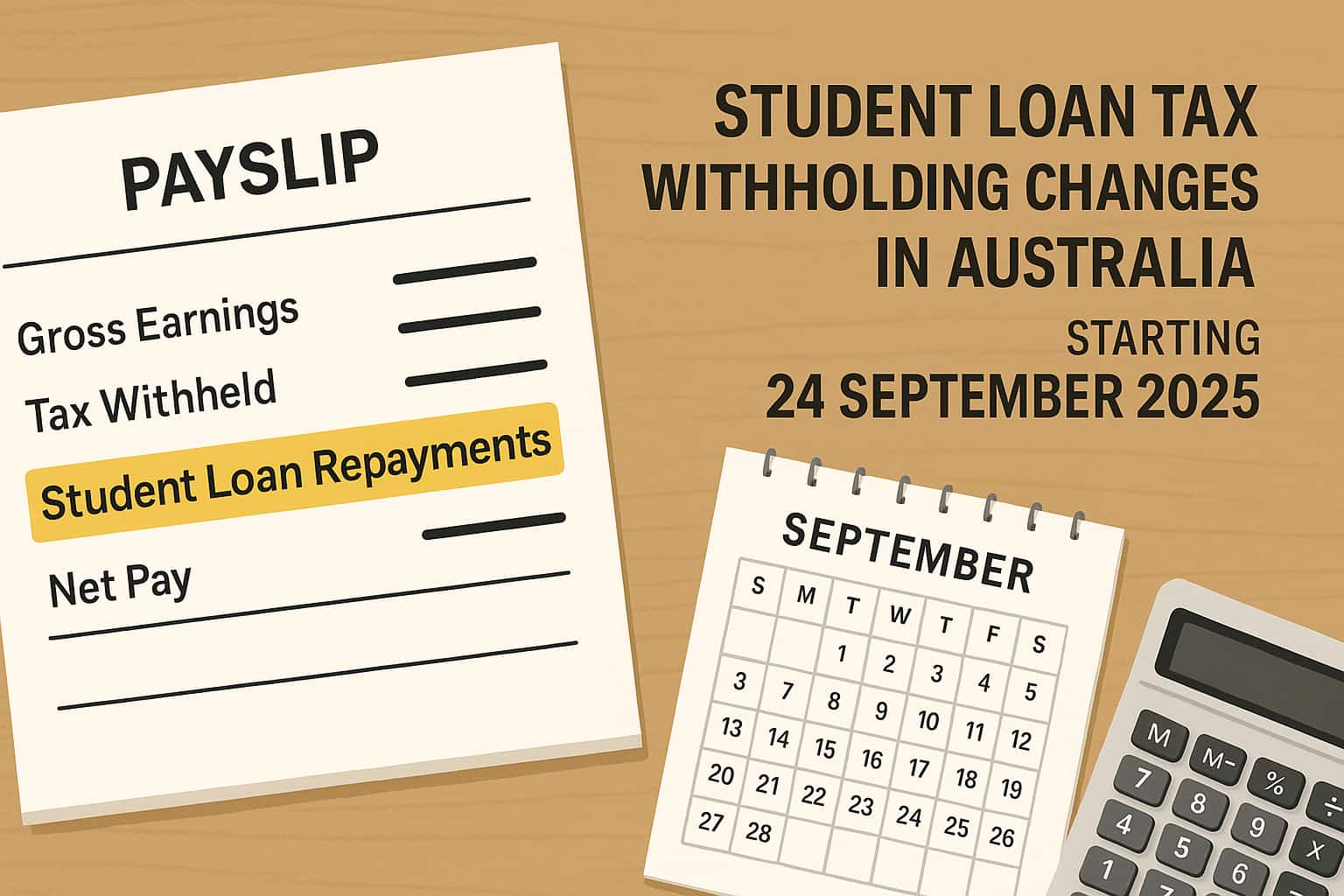From 24 September 2025, the way student loan repayments are handled through your pay will change. Millions of Australians with HELP, VET, and Australian Apprenticeship Support Loans (AASL) will be affected, making this one of the most significant tax shifts in recent years.
If you’re a graduate or early-career worker, this change matters. For years, many taxpayers have found themselves with unexpected debts at tax time because their employer didn’t withhold enough to cover their student loan repayments. The new rules are designed to fix that problem by adjusting repayments throughout the year.
Staying across these updates now will help you avoid surprises and better manage your pay and tax return.
What’s Changing from September 2025?
Currently, employers withhold tax from your pay based on your income, but student loan repayments often aren’t fully accounted for. This means borrowers sometimes owe the ATO a lump sum at tax time, which can come as a shock.
From 24 September 2025, employers will begin adjusting PAYG withholding to include compulsory student loan repayments. That means a little more tax will be taken from your pay each week or fortnight, but it also means fewer nasty surprises when you lodge your return.
Who Will Be Affected by the New Rules?
The changes don’t apply to everyone — but they will impact a huge portion of the workforce. If you have one of the following loans, your employer will begin withholding repayments from your pay after 24 September 2025:
- HELP (formerly HECS-HELP)
- VET Student Loans
- Australian Apprenticeship Support Loans (AASL)
If you fall into these categories, you’ll see the difference in your pay once the new rules take effect. You can read more about these loan types on the ATO’s study and training support loans page.
It’s also important to note that repayments only apply once your income reaches the compulsory repayment threshold. This threshold changes each year, and you can find the latest rates on the ATO’s compulsory repayment guide.
For many younger Australians — especially graduates in their 20s and 30s entering the workforce — this update will have the biggest impact. If you’re starting a new job or moving into a higher income bracket, now is the time to prepare.
How This Will Affect Your Pay and Tax Return
The most noticeable change will be in your take-home pay. Because employers will start withholding student loan repayments during the year, your weekly or fortnightly pay may be slightly lower than you’re used to.
The upside is that you’ll no longer be hit with a large, unexpected debt when lodging your tax return. In the past, many borrowers discovered they hadn’t paid enough toward their loan through PAYG, leaving them with a bill at tax time. Under the new system, repayments are made in real time, reducing the risk of owing the ATO later.
It also means you might not see the same tax refund you’ve had in previous years. For some, refunds could be smaller — and in some cases, you may not receive one at all. That’s not a bad thing; it simply reflects that your repayments are being spread evenly across the year instead of being lumped in at tax time.
To make sure everything is correct:
- Update your TFN declaration with your employer so they can apply the right withholding rate.
- Check your payslips regularly to confirm repayments are being withheld.
- Keep in mind that your cash flow will feel different, so planning ahead is key.
Preparing for the Change
With the new rules starting on 24 September 2025, now is the time to get ready. A few simple steps can help you avoid issues and stay in control of your finances:
- Check your loan balance and repayment status — log in through StudyAssist or the ATO to see if your income and loan balance will trigger compulsory repayments.
- Confirm with your employer — ask payroll or HR whether their systems are set up for the new withholding rules.
- Use ATO calculators and tools — estimate what your repayments will look like under the new system so you can budget accordingly.
- Plan for smaller refunds — adjust your expectations and cash flow planning if you’ve relied on larger refunds in the past.
- Stay organised — keep payslips, loan statements, and tax records handy in case you need to reconcile later.
The shift in student loan tax withholding is designed to make things simpler and fairer. While your take-home pay may be a little smaller, the trade-off is fewer tax-time shocks and more accurate repayments across the year.
If you’re unsure how these changes will affect your situation, getting professional guidance can make a big difference.
Need help navigating the new student loan tax rules? Lodge with TaxReturn.com.au today and make sure your tax return is stress-free.
*General Advice Warning – “Any financial advice provided by TaxReturn.com.au is general in nature and is not personal financial advice. It does not take into account your objectives, financial situation, or needs. Before acting on any information, you should consider the appropriateness of it regarding your own objectives, financial situation and needs.”


